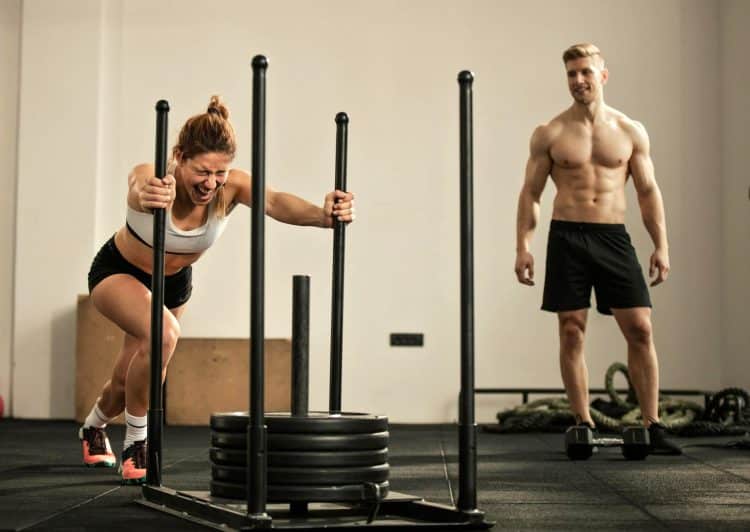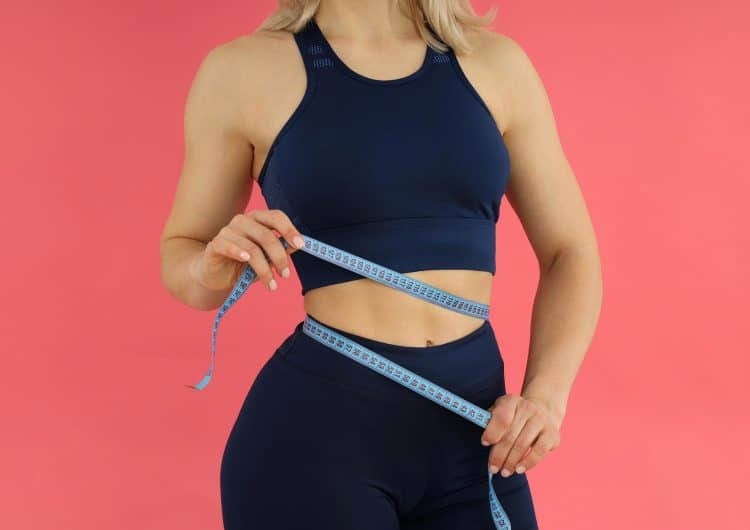Obesity and rapid weight gain have been part and parcel of the modern age. Technological advances combined with new-age working conditions have made us obese at a rapid rate. But it has not been all doom and gloom. With the advancement of medical science, doctors and healthcare professionals are finding new and more effective ways to lose weight and get in shape.
Gone are the days when losing weight meant starving ourselves and working out for hours in the gym. Modern diets, new fasting methods, and workout regimes have revolutionized the fitness and healthcare industries.
In this article, we will look at two of the most popular weight loss trends: HIIT and intermittent fasting, and if they should be combined. We will further evaluate the pros and cons of such a regime and answer all your questions, which will help you decide if it is good for you and your fitness goals.
What is HIIT?

High-Intensity Interval Training (HIIT), as the name suggests, is a workout routine involving short bursts of intense or explosive anaerobic exercise followed by brief recovery periods until the point of exhaustion. In essence, this training method aims to target our cardiovascular system, where the heart rate is elevated for a short period, which helps us quickly build up a sweat, followed by a recovery period where the heart rate comes down to its regular rate.
Typically, an average HIIT workout consists of seven to eight rounds of such exercises and can last between 10 to 30 minutes.
HIIT workouts differ from low-intensity cardiovascular and traditional anabolic workouts, which require lifting heavy weights and focusing on specific body parts. On the contrary, HIIT workouts can include conventional cardiovascular exercises like running, biking, swimming, and other aerobic and body weight exercises that aim to engage the entire body and the cardiovascular system.
Level Up Your Fitness: Join our 💪 strong community in Fitness Volt Newsletter. Get daily inspiration, expert-backed workouts, nutrition tips, the latest in strength sports, and the support you need to reach your goals. Subscribe for free!
Read also: HIIT Workouts for Women
What is the Goal of HIIT?
HIIT has gained popularity over the past few decades. But some people might question the effectiveness of HIIT workouts since they are very short workout routines and only require a few types of movements compared to traditional anabolic workouts. Here are the several benefits and goals of HIIT workout routines in this context:
1. More Calories Burnt in a Short Period
One of the primary advantages of HIIT workouts is that they can burn significantly more calories than traditional cardiovascular and anabolic workout routines . A recent study compared the number of calories burned during 30 minutes of high-intensity interval training (HIIT), anabolic strength training, and regular cardiovascular exercise.
The results revealed that HIIT exercises burned almost 20–30% more calories than aerobic exercises like biking and jogging. The researchers also pointed out that compared to other traditional workout routines, HIIT workouts require less duration of exertion as almost two-thirds of the 30 minutes were spent in low-resistance recovery. [1]

2. High Metabolic Rate
The basal metabolic rate of a person translates to the amount of energy required to maintain homeostasis. The higher the metabolic rate, the better it is for weight loss. Studies have pointed out that HIIT workouts increase the body’s metabolic rate, often lasting for hours after the HIIT workout session. [2]
3. Fat Loss
Most studies suggest that HIIT workouts are a great way to reduce body fat and lose weight. In some cases, it is seen that HIIT workouts force the body to use fat instead of carbohydrates as a chief source of energy. The combination of these two factors points out that HIIT exercises can be beneficial for obese people who are looking to lose weight in a short period. [3]
4. Improve Oxygen Consumption
Our muscles require oxygen for optimal functioning and staying healthy. Traditionally, this is done by improving cardiovascular health and performing cardio exercises like jogging, cycling, etc. for extended periods. HIIT workouts have proven to improve the oxygen consumption of our muscles in a significantly shorter period. [4]
5. Reduces Blood Pressure and Heart Rate
People who suffer from obesity generally tend to have poor heart health, often leading to a high heart rate and an above-average blood pressure level. Studies have shown that following a HIIT workout routine can significantly lower blood pressure levels and normalize the heart rate of obese people. It must be pointed out that traditional cardiovascular exercises yielded a similar result, but HIIT workout routines were much shorter compared to low-intensity steady-state (LISS) cardiovascular exercises. [5]
6. Reduces Blood Sugar Levels
Studies have shown that compared to traditional cardiovascular exercises, HIIT workout routines are much more effective in lowering blood sugar levels. It has also been proven effective in improving insulin resistance in people with type 2 diabetes. [6]
What is Intermittent Fasting?
Intermittent fasting (IF) is one of the most popular fasting programs. Essentially, it is a time-restrictive diet that encourages people to consume food during a specific eating window and fast for the rest of the day. Weight loss in intermittent fasting is related to how the body breaks down the stored fat in the state of ketosis.
During the fasting period, your body requires energy to maintain regular homeostasis. This energy is generally obtained from the food we consume. But in the case of a person who is fasting, the body does not have the required food resources, so it has to look for other energy sources like stored fat. The body breaks down this stored fat through a process known as ketosis. Sustained ketosis leads to the breaking down of fat resources in the body, which eventually leads to weight loss.

What is the Goal of Intermittent Fasting?
Intermittent fasting can be pursued in different forms, like the 16:8 hour fast , the 5:2 day fast, the alternate day fast, etc. Each of these fasting methods has unique benefits. Still, for clarity, we will point out the general benefits associated with intermittent fasting.
1. Fat Loss
It is one of the primary benefits of intermittent fasting. Although intermittent fasting does not include calorie restriction, studies have found that people who follow intermittent fasting can lose considerable weight. It is because intermittent fasting forces the body to undergo ketosis and break down the stored fat, leading to gradual weight loss. [7]
2. Promotes Insulin Resistance
Insulin is the hormone created by the pancreas responsible for the amount of glucose in our bloodstream. People with type 2 diabetes or somewhat vulnerable to type 2 diabetes struggle with insulin resistance. Studies have shown that intermittent fasting can improve the body’s insulin resistance, which automatically lowers blood sugar levels. [8]
3. Improves Heart Health
Intermittent fasting is beneficial for different health markers directly responsible for better heart health, including blood cholesterol levels, blood sugar levels, total blood triglycerides, inflammatory markers, and body weight. Although the studies are not at an advanced stage, based on the effect of intermittent fasting on these health markers, we can say that intermittent fasting can positively impact our heart health. [9]
4. Cell Repair
Studies have shown that prolonged periods of fasting can initiate a process called cellular autophagy. In essence, cellular autophagy refers to the act when the cells of our body start to eat other weak and damaged cells and simultaneously replace them with newer, healthier cells. Cellular autophagy can be highly beneficial for cellular health and activity. [10]
5. Reduces Oxidative Stress
Oxidative stress refers to the presence of free radicals in the body, which react with the other essential elements present in the body and damage them. Intermittent fasting has been proven to help the body combat oxidative stress, further protecting us from aging and several chronic diseases. [11]
6. Combats Inflammation
Studies have proven that intermittent fasting helps the body fight inflammation, which is the root cause of several chronic health hazards. [12]
Can I Combine IF and HIIT as They Have the Same Goal?
Both HIIT and intermittent fasting have very similar goals and benefits. Both aim to reduce body fat, increase the body’s insulin resistance, improve heart health, etc. The only difference is that HIIT is a form of workout, whereas intermittent fasting is a diet.
So it is only natural to combine these methods to obtain the fastest fat loss results. HIIT is relatively short and can be combined with intermittent fasting as working out for long hours in a fasted state can be challenging.
Level Up Your Fitness: Join our 💪 strong community in Fitness Volt Newsletter. Get daily inspiration, expert-backed workouts, nutrition tips, the latest in strength sports, and the support you need to reach your goals. Subscribe for free!
Combined Benefits of Intermittent Fasting and HIIT
Here are the benefits of performing a HIIT workout while simultaneously implementing an intermittent fasting diet:
1. Rapid Fat Burn
Studies have shown that our body performs some form of ketosis while in a fasted state. When we include a HIIT workout, this triggers the body to burn even more fat and leads to a higher rate of weight loss. [13]

2. Regulation of Growth Hormones
Several studies have pointed out that fasting leads to the body producing higher amounts of growth hormone. Hence, if we perform HIIT workout routines while fasting, then the body can use these high amounts of growth hormone to build muscles and regulate the level of growth hormone present in the body. [14]
3. Controlled Sugar Levels
Intermittent fasting and HIIT workouts reduce blood sugar levels.
4. Lowers the Risk of Heart Disease
Medical professionals and doctors suggest some form of cardiovascular exercise daily to improve our heart health. As mentioned above, intermittent fasting positively affects the health markers responsible for better cardiovascular health. So, combining HIIT and intermittent fasting can lower the risk of heart disease.
5. Can Help Treat Type 2 Diabetes
Lower insulin resistance is one of the primary reasons for type 2 diabetes. Incidentally, HIIT and intermittent fasting improves the body’s insulin resistance. Combining HIIT and intermittent fasting can help treat type 2 diabetes. [15]
6. Boosts Pancreas Function
Some preliminary studies suggest that fasting helps the beta cells in the pancreas to manage the body’s blood glucose levels. [16]
Downsides of Combining Intermittent Fasting with HIIT
Here are some of the downsides related to combining intermittent fasting with HIIT:
1. Fatigue
Fasting for prolonged periods can cause fatigue, leading to lethargy and weakness. Adding a high-intensity workout to this can make matters worse.
2. Muscle Loss
Fat loss is one of the key benefits of intermittent fasting and HIIT workouts. However, it can lead to rapid muscle loss if you do not follow a balanced diet.
3. Stress
Following HIIT and IF simultaneously can be highly stressful and cause panic attacks or shock. It is always better to maintain a balance while combining intermittent fasting and HIIT.
So, Should I Combine Intermittent Fasting with HIIT?
Although combining intermittent fasting with HIIT has its benefits, it also has certain downsides. It would be best to take proper precautions before combining these two programs. Additionally, you could start with either intermittent fasting or HIIT and only include the other when you are sure your body can handle both simultaneously.
HIIT Plan to Follow While Intermittent Fasting

Numerous HIIT plans with different intensity levels can be performed while following an intermittent fasting plan. Given below is a HIIT plan which can be followed by most people while intermittent fasting:
- High knees (45 seconds)
- Mountain climber (45 seconds)
- Burpee (45 seconds)
- Side plank raise (20 seconds on each side)
- Russian twist (45 seconds)
- Lunge (45 seconds)
- Push-up (45 seconds)
- Jumping jacks (45 seconds)
- Jump squat (45 seconds)
Perform three rounds of this circuit. You are allowed a 15-second rest after each exercise and a 2-3 minute rest between each circuit. Resting for longer will hamper your training intensity.
Tip: It is better to do slow, controlled movements with fewer repetitions than fast movements with bad form, which can cause injury.
Who Should Avoid Combining Intermittent Fasting With HIIT?
Combining intermittent fasting and HIIT can put your body under immense stress. It is not recommended for people with certain underlying health risks. Here are some people who should avoid combining intermittent fasting with HIIT:
1. Pregnant Women
Pregnant women should avoid HIIT workouts and any fasting since they require the best nutrition during pregnancy. These programs can be stress-inducing, which can cause certain pregnancy-related complications.
2. People with Nutritional Deficiencies
People with some nutritional deficiencies should avoid intermittent fasting and HIIT as they can cause further complications.
3. People with Severe Medical Conditions
People with underlying medical conditions should avoid intermittent fasting and HIIT as it can worsen their condition.
4. People Already Stressed Due to Intermittent Fasting or HIIT
As mentioned earlier, intermittent fasting and HIIT can be stressful. Hence, people who feel stressed by following these routines should stop immediately.
Frequently Asked Questions
What is the right time for HIIT on intermittent fasting?
Although there are no hard and fast rules for it, some experts suggest that it is better to perform HIIT workouts right at the end of the fasting period.
Why am I not losing weight even after combining intermittent fasting and HIIT?
Weight loss generally depends on a lot of different factors. One of the reasons for suboptimal weight loss can be a lack of or insufficient calorie deficit. You should burn more calories than you eat in a day to lose weight gradually.
During Ramadan fasting month, is it alright to do a HIIT workout 10-20 minutes before breaking my fast?
The Ramadan fast is a dry fast, so doing a HIIT workout while performing a Ramadan fast can be difficult for some people.
While doing alternate-day fasting, is it okay to work out during my fasting days to burn more fat? If so, should I do cardio or strength training?
Yes, while performing alternate-day fasting, working out during the fasting days is fine. Furthermore, cardio training is preferred as it can help with weight loss.
Should you eat after HIIT if you want to shed body fat?
Eating after performing a HIIT workout is perfectly normal as long as the calorific value of the meal is within the daily requirement range.
Learn more about fasting
- Anabolic Fasting: Learn About Building Muscle and Losing Fat Simultaneously
- I’m a Fasting Expert: This is the One Mistake That Destroys Fat Loss During IF
- Inflammation Calculator & Personalized Action Plan
- Dry Fasting Calculator: Estimate Your Weight Loss & Safety Risks
- Intermittent Fasting Weight Loss Calculator: Discover How Much You Can Lose
- Intermittent Fasting vs. Small Meals: Which is Best for Weight Loss?
Final Thoughts
Intermittent fasting and HIIT workouts are great for people who want to lose weight. Combining the two can speed up your weight loss progress. Plus, it has several other health benefits. However, you should consider the drawbacks associated with combining the two before making the final call.
To conclude, combining intermittent fasting and HIIT is considered a very effective weight loss strategy. However, the results are debatable and may vary from person to person.
References
- “Caloric Expenditure of Aerobic, Resistance, or Combined High-intensity Interval Training Using a Hydraulic Resistance System in Healthy Men – PubMed.” PubMed , 1 Mar. 2015, pubmed.ncbi.nlm.nih.gov/25162652.
- “The Acute Effect of Exercise Modality and Nutrition Manipulations on Post-exercise Resting Energy Expenditure and Respiratory Exchange Ratio in Women: A Randomized Trial – PubMed.” PubMed , 1 Dec. 2015, pubmed.ncbi.nlm.nih.gov/27747847.
- “The Effects of High-intensity Interval Training Vs. Moderate-intensity Continuous Training on Body Composition in Overweight and Obese Adults: A Systematic Review and Meta-analysis – PubMed.” PubMed , 1 June 2017, pubmed.ncbi.nlm.nih.gov/28401638.
- “Comparison of High-Intensity Interval Training and Moderate-to-Vigorous Continuous Training for Cardiometabolic Health and Exercise Enjoyment in Obese Young Women: A Randomized Controlled Trial – PubMed.” PubMed , 1 July 2016, pubmed.ncbi.nlm.nih.gov/27368057.
- “High-intensity Interval Training for Reducing Blood Pressure: A Randomized Trial Vs. Moderate-intensity Continuous Training in Males With Overweight or Obesity – PubMed.” PubMed , 1 May 2020, pubmed.ncbi.nlm.nih.gov/31937915.
- “The Effects of High-intensity Interval Training on Glucose Regulation and Insulin Resistance: A Meta-analysis – PubMed.” PubMed , 1 Nov. 2015, pubmed.ncbi.nlm.nih.gov/26481101.
- Liu, Jingliang, et al. “Intermittent Fasting Reshapes the Gut Microbiota and Metabolome and Reduces Weight Gain More Effectively Than Melatonin in Mice – PMC.” PubMed Central (PMC) , 24 Nov. 2021, www.ncbi.nlm.nih.gov/pmc/articles/PMC8652062.
- “Intermittent Fasting Vs. Daily Calorie Restriction for Type 2 Diabetes Prevention: A Review of Human Findings.” Intermittent Fasting Vs. Daily Calorie Restriction for Type 2 Diabetes Prevention: A Review of Human Findings – ScienceDirect , 12 June 2014.
- DONG, Tiffany A., et al. “Intermittent Fasting: A Heart Healthy Dietary Pattern? – PMC.” PubMed Central (PMC) , 21 Apr. 2020.
- Godar, Rebecca J., et al. “Repetitive Stimulation of Autophagy-lysosome Machinery by Intermittent Fasting Preconditions the Myocardium to Ischemia-reperfusion Injury – PMC.” PubMed Central (PMC) , 23 June 2015, www.ncbi.nlm.nih.gov/pmc/articles/PMC4590628.
- Cienfuegos, Sofia, et al. “Effects of 4- and 6-h Time-Restricted Feeding on Weight and Cardiometabolic Health: A Randomized Controlled Trial in Adults With Obesity: Cell Metabolism.” Cell Metabolism , 1 Sept. 2020.
- Jordan, Stefan, et al. “Dietary Intake Regulates the Circulating Inflammatory Monocyte Pool: Cell.” Cell , 22 Aug. 2019.
- “Effects of Aerobic Exercise Performed in Fasted V. Fed State on Fat and Carbohydrate Metabolism in Adults: A Systematic Review and Meta-analysis – PubMed.” PubMed , 1 Oct. 2016, pubmed.ncbi.nlm.nih.gov/27609363.
- “Augmented Growth Hormone (GH) Secretory Burst Frequency and Amplitude Mediate Enhanced GH Secretion During a Two-day Fast in Normal Men – PubMed.” PubMed , 1 Apr. 1992, pubmed.ncbi.nlm.nih.gov/1548337.
- Kume, Shinji, et al. “Hypothalamic AMP-Activated Protein Kinase Regulates Biphasic Insulin Secretion From Pancreatic Β Cells During Fasting and in Type 2 Diabetes – PMC.” PubMed Central (PMC) , 28 Oct. 2016, www.ncbi.nlm.nih.gov/pmc/articles/PMC5264491.
- “Impact of Endurance Exercise Training in the Fasted State on Muscle Biochemistry and Metabolism in Healthy Subjects: Can These Effects Be of Particular Clinical Benefit to Type 2 Diabetes Mellitus and Insulin-Resistant Patients? – PubMed.” PubMed , 1 Mar. 2017, pubmed.ncbi.nlm.nih.gov/27459862.









